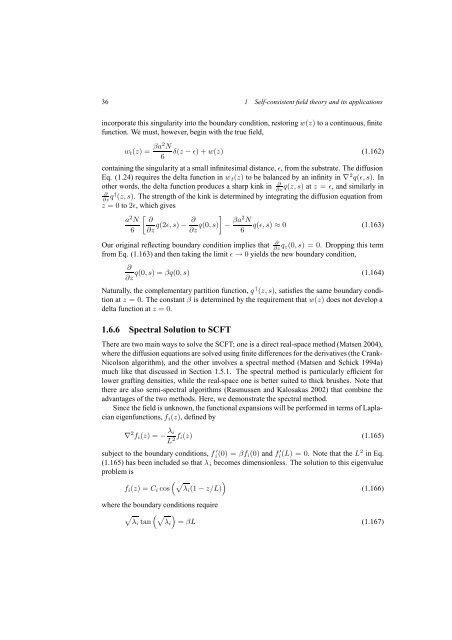Self-Consistent Field Theory and Its Applications by M. W. Matsen
Self-Consistent Field Theory and Its Applications by M. W. Matsen
Self-Consistent Field Theory and Its Applications by M. W. Matsen
You also want an ePaper? Increase the reach of your titles
YUMPU automatically turns print PDFs into web optimized ePapers that Google loves.
36 1 <strong>Self</strong>-consistent field theory <strong>and</strong> its applications<br />
incorporate this singularity into the boundary condition, restoring w(z) to a continuous, finite<br />
function. We must, however, begin with the true field,<br />
w t (z) = βa2 N<br />
δ(z − ɛ)+w(z) (1.162)<br />
6<br />
containing the singularity at a small infinitesimal distance, ɛ, from the substrate. The diffusion<br />
Eq. (1.24) requires the delta function in w t (z) to be balanced <strong>by</strong> an infinity in ∇ 2 q(ɛ, s). In<br />
other words, the delta function produces a sharp kink in ∂ ∂zq(z,s) at z = ɛ, <strong>and</strong> similarly in<br />
∂<br />
∂z q† (z,s). The strength of the kink is determined <strong>by</strong> integrating the diffusion equation from<br />
z =0to 2ɛ, which gives<br />
a 2 N<br />
6<br />
[ ∂<br />
∂z q(2ɛ, s) − ∂ ∂z q(0,s) ]<br />
− βa2 N<br />
q(ɛ, s) ≈ 0 (1.163)<br />
6<br />
∂<br />
∂z q z(0,s)=0. Dropping this term<br />
Our original reflecting boundary condition implies that<br />
from Eq. (1.163) <strong>and</strong> then taking the limit ɛ → 0 yields the new boundary condition,<br />
∂<br />
q(0,s)=βq(0,s) (1.164)<br />
∂z<br />
Naturally, the complementary partition function, q † (z,s), satisfies the same boundary condition<br />
at z =0. The constant β is determined <strong>by</strong> the requirement that w(z) does not develop a<br />
delta function at z =0.<br />
1.6.6 Spectral Solution to SCFT<br />
There are two main ways to solve the SCFT; one is a direct real-space method (<strong>Matsen</strong> 2004),<br />
where the diffusion equations are solved using finite differences for the derivatives (the Crank-<br />
Nicolson algorithm), <strong>and</strong> the other involves a spectral method (<strong>Matsen</strong> <strong>and</strong> Schick 1994a)<br />
much like that discussed in Section 1.5.1. The spectral method is particularly efficient for<br />
lower grafting densities, while the real-space one is better suited to thick brushes. Note that<br />
there are also semi-spectral algorithms (Rasmussen <strong>and</strong> Kalosakas 2002) that combine the<br />
advantages of the two methods. Here, we demonstrate the spectral method.<br />
Since the field is unknown, the functional expansions will be performed in terms of Laplacian<br />
eigenfunctions, f i (z), defined <strong>by</strong><br />
∇ 2 f i (z) =− λ i<br />
L 2 f i(z) (1.165)<br />
subject to the boundary conditions, f i ′(0) = βf i(0) <strong>and</strong> f i ′(L) =0. Note that the L2 in Eq.<br />
(1.165) has been included so that λ i becomes dimensionless. The solution to this eigenvalue<br />
problem is<br />
(√ )<br />
f i (z) =C i cos λi (1 − z/L)<br />
(1.166)<br />
where the boundary conditions require<br />
√<br />
λi tan<br />
(√<br />
λi<br />
)<br />
= βL (1.167)
















